BAILOUT! John Sandulak's story
text from 1993 In Carman p36-37
| "Bail out! Emergency parachute!"
came over the intercom. Sgt. John Sandulak of Sperling,
Manitoba didn't need instructions because both starboard
engines were on fire, and flames from the ruptured gas tanks
were streaming back about 100 feet, almost engulfing the rear
turret where he sat manning the four Browning machine guns. He
yanked out the intercom plugs and grabbed his parachute from
behind the turret in the fuselage.
It was July 24/44. Johnny and his crew had taken off just before dark from Middleton St. George, Yorkshire in their Lancaster bomber. They were with No. 428 Ghost Sqdn. in No. 6 Canadian Group and were headed for Stuttgart, Germany, with over 11,000 pounds of bombs on board. Flying at 25,000 feet on an individual course, they had suddenly collided with another aircraft. Everything happened so fast no one could tell what really happened. Both starboard engines had almost exploded and chances of losing a wing were very probable. |
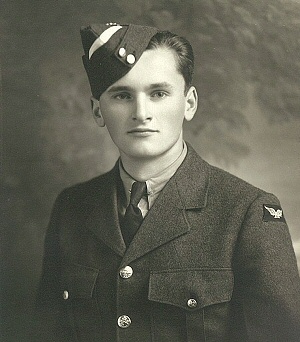 R208898 John Sandulak when training |
F/S Cecil Bus Corbett, the pilot, of Owen Sound, Ontario had yelled "Bail out", but almost immediately had said "hold it, maybe the fire will go out." (F/S Corbett never got too excited at any time.)
Johnny, however, did not hear this. He buckled on his parachute and reversed his hydraulic turret. One foot caught in the controls, then suction grabbed him and he hit his head on something. The next thing he remembered was floating down through cold space with his helmet gone and one flying boot missing. Down below an aircraft was burning — it must be the one that had collided with them. During the collision he had only a fleeting glimpse of a shadow of an another aircraft with no time to give a warning. He hit the ground hard in the dark, but did not feel much damage. The other burning aircraft was not far away. When he heard distant voices he grabbed the chute and shoved it under a stook. He had landed in a field of stooked oats the moonlight showed.
Photo - Sandulak, Jones, Bryans, Corbet, McNaught and Davidson.
Back in the Lanc F/S Corbett called to F/O G. F. Jones of Saskatoon, the Bomb Aimer, to get rid of those bombs fast.
A fast look showed the bomb bays torn off and a piece only hanging by a hinge. It seemed safe to jettison.
"Let them go! We may have a chance of getting back to England with those bombs gone. The fires are nearly out and both props are feathered" ordered Corbett.
F/O Jones dropped the bombs and the aircraft seemed to level itself out. Sgt. Dick Enfield, the Flight Engineer, and only Brit on board, reported that the remaining gas would get them home if there were no leaks. But he added that the port inner was running rough. They all agreed that it was also damaged in the crash and had bent blades. Sgt. S. T. Stew Bryans from Mitchell, Ont. was the nav. He immediately set course for the R.A.F. emergency airdrome at Woodbridge, Sussex. (During the war some 4100 Allied aircraft made emergency landing at this drome.)
| The WOp/AG Sgt. A. R. McNaught of
Weyburn, Sask. prepared to send an S.O.S. or Mayday
to warn the airdrome of their possible arrival.
It was a long way from near Paris to southern England to fly on an engine and a half. Maybe the engines couldn't take the added strain. However, all fliers knew those Rolls Royce Merlin engines were the best so it was a gamble. Sgt. Tom Davidson of Castlegar, B.C. who was mid-upper gunner, decided to check on his fellow gunner in the rear turret. It was empty, and Johnny's parachute was in the fuselage! He'd jumped with no chute? "I guess Johnny has bought it because here's his chute with his name on it" reported Davidson. Somehow an extra chute had been left in the aircraft. As Johnny says, "I just grabbed a chute and didn't look to see whether my name was on it." For nearly a year the crew thought that Johnny had died. |
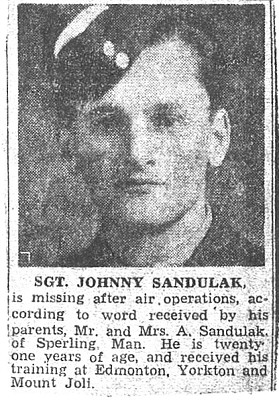 |
"For a couple of days I stayed with a French family, wearing old clothes, and even hoeing sugar beets," claims Johnny. "Then the underground arrived. I was interrogated, cleared and taken to the Forest of Freteval".
This was a camp southwest of Paris where eventually 152 Allied airmen were collected. There were about 25 Canadians, the others were American, British, Aussies, and New Zealanders.
In early 1944 a Belgian, Jean De Blommaert, convinced the R.A.F. that it was too dangerous to evacuate Allied airmen via submarine, airlifts or through Spain. The invasion couldn't be too far off and he suggested hiding the airmen where they could. The middle of the big forest was selected. They called themselves the Escadrille 69 and their passport was a 100 franc note signed by many of the escapees. Two rules had to be observed. Do not escape, and keep quiet because the Germans are all around. It was here that Johnny later met Lou Greenburgh of Winnipeg (eee Story Berlin Again).
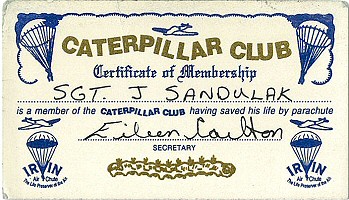 |
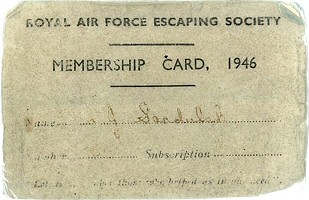 |
They never met again till 1970 at the First Commonwealth Aircrew Reunion in Winnipeg and again at the second reunion in 1976.
Liberation came in early September and all were flown back to England.
And what of Johnny's crew? They made Woodbridge dead on course. It was a wheels up landing, with lots of tearing and scraping of metal but no fire. They all got a week's leave and came back for their fourth mission. A new Air Gunner, F/S Good, from Flin Flon area in Manitoba, was added. He had almost finished his tour and needed a new crew.
On August 19 1944 they were on another raid over Bremen when all of a sudden the Lancaster reared up on its four propellers. Again the order of "bail out" was heard. This time they all jumped - except F/S Good. Somehow their tail had been blown off. Maybe it was a direct hit from the a. a. fire below, or a bomb dropped from above, or another aircraft friendly or enemy colliding with them again. No one will ever know and F/S Good was never found.
"But I often wonder whether it's luck or fate that things happened as they did so that I wasn't in that blown off tail" muses Johnny.
The old crew except Enfield, all met in Winnipeg in August /45 after getting out of POW camp. Johnny had telegraphed them in Bournemouth, England in May saying he was alive. Since then they "keep in touch". Bus Corbett his wife lived in Winnipeg for some time but both died in 1971 leaving three daughters. The others are all in "old home territory".
Today Johnny and Wilma live on the outskirts of Carman, Manitoba, where he and two of his sons run a big farm. Two daughters are married and on their own, and two more children are still in school. Wilma had had her eye on Johnny for a long time. His picture was in the local paper so often - enlistment, graduation, overseas, missing in action, and when he returned safe. They finally met for the first time when he returned. She had plans already!
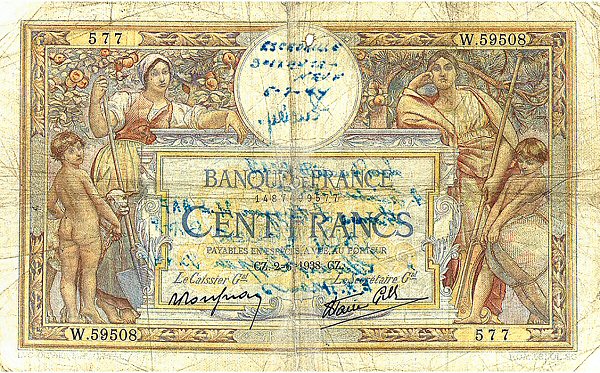
ESCADRILLE SOIXANTE-NEUF
5-7-44
please click on note above for a larger image
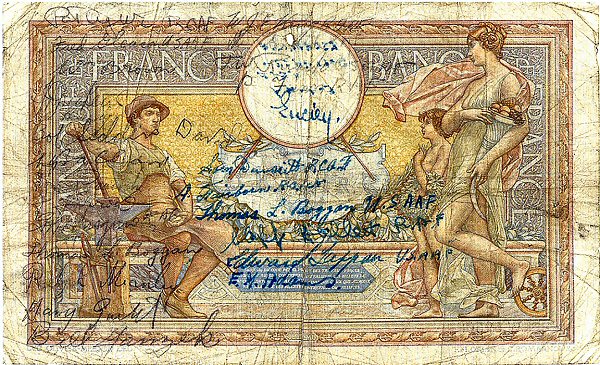
please click on note for a larger image
Column 1Pat Agur RCAF |
Column 2above circle |
click here for other banknote images on this website
images and article: Sandulak family
page last updated 11 Apr 2010
If you can add to this page please contact the editor